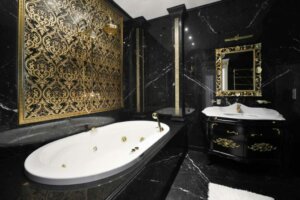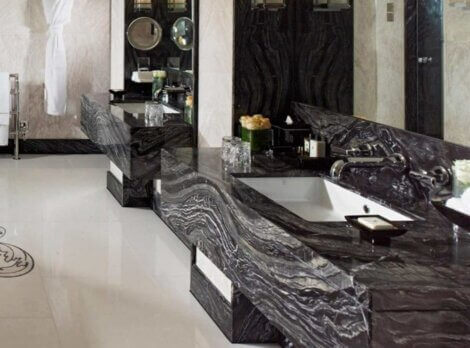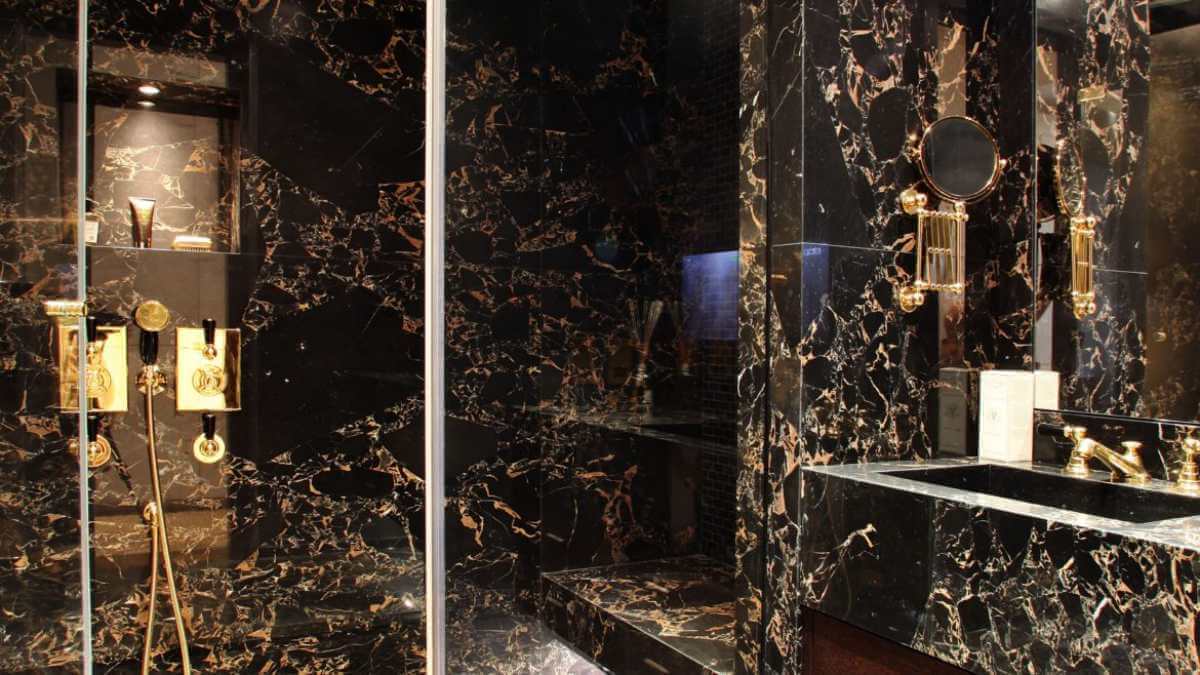Would You Like a Black Marble Bathroom?

The black marble bathroom is an alternative image. What’s more, it projects a serious and robust ambiance that dominates the entire room.
This imposing type of decor can be achieved through dark tones that transmit severity, strength, and stability. That’s why we’re going to learn about black marble bathrooms, a trend that is gaining popularity.
Generally, we tend to choose cool, soft, and peaceful colors for interiors. In fact, they’re the most common and have conservative patterns. However, we do have the option to change and seek out other aesthetic alternatives that are more unique.
Whenever you walk into a room and discover different decor from what you expect, it’s a shock and it surprises you because it’s original, odd, and innovative. You’ll find that more and more interior designers use resources that stand out.
A serious and impressive material

Image: tinostone,com
Marble is a type of rock that has numerous qualities. Among them are strength, resistance, elegance, and an outstanding appearance. Also, it produces a certain sparkle that offers refinement and grace and it’s available in various colors.
Black is not often used in interior design. Nevertheless, in the designer world, it’s more common. In any area, it goes well with the other colors and has a functional side, but it’s not found frequently in homes.
Basically, this is due to its strength. Because it’s intense and powerful, if it covers the walls or the floor, it has the capacity to overwhelm. Normally, you’ll see it in hotels, restaurants and public places.
It’s time to introduce a color that has presence in your home.
A black marble bathroom

Image: granitomarmal.com
Why not break with the domination of white in the bathroom and have a new aesthetic look with black? It’s a golden opportunity to include a different decorative perspective. In other words, a new image. So consider the following aspects in relation to this color:
1.On the walls, it produces a captivating character and gives the space energy and seriousness. It adds sophistication and creates an attractive visual effect since it’s something out of the ordinary.
2. The feeling of cleanliness and hygiene. These tend to be associated with white. However, black also encompasses this and gives that sensation of a clean space that we all want.
3. Black marble on the floor is interesting because it provides a feeling of stability and balance in the environment. It contributes delicacy and richness to the bathroom. As a result, your guests will know that you have good taste.
4. You should realize that you can’t combine marble with any color. This is because the idea of being random doesn’t work with black marble. But some colors that do go well with it are forest green, beige, or brown wood tones.
Combining black marble and white

Image: mundopetreo.com
If you have to choose a color that combines with black marble the best, white is the ultimate option. The reason is that neither of the two is garish so they don’t cause aesthetic tension. In reality, they create a perfect union between light and dark.
Toilets tend to be white, so the walls or floors will need to be black. However, there’s also the option of putting both colors on the walls, alternating each.
Basically, this is a way to make the atmosphere more dynamic and not so bland. Black can be imposing and reflect too much power. That’s why counteracting it with another color will produce a good result.
Needless to say, black marble has a dominant character.
Black marble bathrooms

Image: Marmoleria y Santitario Guarira/Facebook
It’s unusual to find a black marble bathroom. Being a smooth and soft stone, it makes sense to use this type of material. By using it, you can obtain a certain originality and give the bathroom a different image.
A black sink is a good bet, especially together with a wooden vanity, or if the walls are white. What tends to be uncommon is a black marble toilet.
All cited sources were thoroughly reviewed by our team to ensure their quality, reliability, currency, and validity. The bibliography of this article was considered reliable and of academic or scientific accuracy.
- Lluch, Francisco Javier: Arte de armonizar los colores, Imprenta de El Porvenir, Barcelona, 1858.








